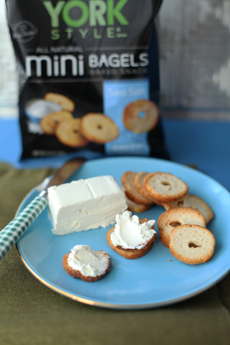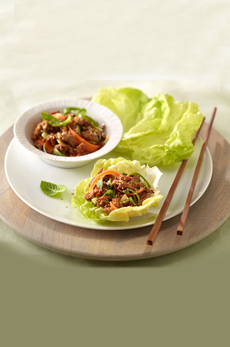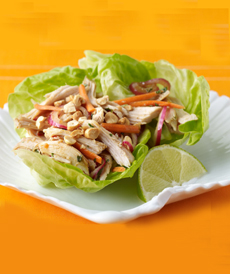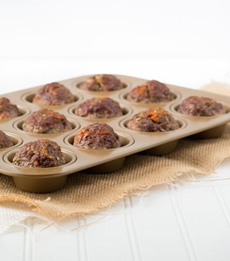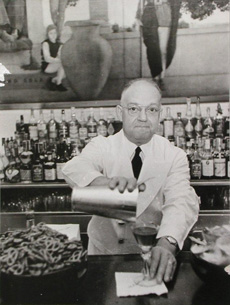
[1] Thank bartender Fernand Petiot for today’s Bloody Mary (photos #1 and #3 © St. Regis Hotel | NYC).
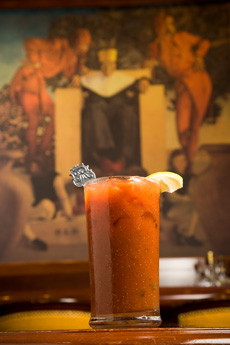
[2] The Bloody Mary was originally called the Red Snapper.
|
|
January 1st is National Bloody Mary Day; 2015 marks the 81st anniversary of the drink, originally known as the Red Snapper Cocktail.
In 1934, a seminal cocktail event took place at the King Cole Bar, an elegant watering hole in the storied St. Regis hotel in New York City. Bartender Fernand Petiot introduced the Red Snapper, a cocktail that would later be renamed the Bloody Mary.
A simple cocktail called the Bloody Mary—gin and tomato juice—originated in the 1920s at a Parisian bar called The New Yorker. Petiot had served the drink at Harry’s Bar in Paris.
After moving to the St. Regis, Petiot spiced up a tomato juice and vodka libation with celery salt, pepper, cayenne, lemon, and Worcestershire sauce.
There’s more Bloody Mary history below.
RECIPE: THE ORIGINAL RED SNAPPER COCKTAIL FROM THE KING COLE BAR
Ingredients
2 ounces tomato juice
1 dash lemon juice
2 dashes celery salt
2 dashes black pepper
2 dashes cayenne pepper
3 dashes of Worcestershire sauce
1 ounce vodka
Preparation
COMBINE all ingredients and serve over ice.
The vodka-based drink became known as the Bloody Mary, and the gin-based equivalent became known as the Red Snapper. Over time, hot sauce replaced the cayenne pepper and a celery stick garnish appeared.
And the name switched: The Red Snapper became a cocktail like the vodka-based Bloody Mary, but with gin instead.
|
If you’re a Bloody Mary fan, try a Red Snapper instead and see what the more flavorful gin does for the drink, as opposed to the neutral flavor of vodka.
|
|
MORE BLOODY MARY HISTORY
The St. Regis Hotel was opened in 1904, built by one of the wealthiest men in America, John Jacob Astor IV, as a companion to the Waldorf-Astoria Hotel.
Eight years later, John Jacob Astor IV perished in the sinking of the RMS Titanic. His son Vincent Astor inherited the hotel.
In 1932, the “Old King Cole” mural by Maxfield Parrish, which had been created for Astor’s defunct Knickerbocker Hotel, was moved to the St. Regis and made the centerpiece of a new bar, the King Cole Bar. In 1934, Vincent Astor recruited French bartender Fernand “Pete” Petiot, who had moved to New York from Paris-based Harry’s New York Bar in the 1920s, as the head bartender.
At Harry’s, Petiot was famed for a tomato juice and vodka drink that was named the Bloody Mary, as the story goes, after a customer named Mary.
When he brought the drink to New York, Petiot had to swap out the vodka, which was hard to come by in the U.S. (until the 1960s), for gin. Then, the Astor family deemed the name Bloody Mary too déclassé for their society clientele. So the Red Snapper was born.
|
|

[3] While early Bloody Marys were garnished with a celery stick and line wedge, in recent decades bartenders have been adding more garnishes: other vegetables, cheeses, meats, and more (photo © The Wayfarer | NYC).
|
In 1934, Prince Serge Obolensky, a well-known man about town whose penchant for vodka was in keeping with his aristocratic Russian background, asked Petiot to make the vodka cocktail he had in Paris.
According to FoodRepublic.com, Petiot spiced up the Parisian Bloody Mary—originally just vodka and tomato juice—with salt, pepper, lemon, and Worcestershire Sauce. Since “Bloody Mary” was deemed too vulgar for the hotel’s elegant King Cole Bar, the drink was rechristened the “Red Snapper.” While the name may not have endured, the spicy drink most certainly has; over the years it has become the signature cocktail of the King Cole Bar. Sometime in the mid-1930s, the name reverted to Bloody Mary—a better, spicy Mary, to be sure.
CHECK OUT WHAT’S HAPPENING ON OUR HOME PAGE, THENIBBLE.COM.
|
|
